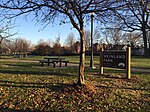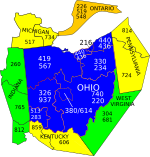Felix A. Jacobs House
Columbus, Ohio building and structure stubsColumbus metropolitan area, Ohio Registered Historic Place stubsHouses completed in 1905Houses in Columbus, OhioHouses on the National Register of Historic Places in Ohio ... and 1 more
National Register of Historic Places in Columbus, Ohio

The Felix A. Jacobs House is a historic house in the Weinland Park neighborhood of Columbus, Ohio, United States. The house was built c. 1905-10 and was listed on the National Register of Historic Places in 1986.The house is now known as the Huckleberry House, a shelter for youth. Within the house there are multiple different programs all for supporting youth with mental, emotional, and physical problems. It is a safe space for the troubled kids to come and stay (overnight if they want) and receive assistance.
Excerpt from the Wikipedia article Felix A. Jacobs House (License: CC BY-SA 3.0, Authors, Images).Felix A. Jacobs House
Hamlet Street, Columbus
Geographical coordinates (GPS) Address Nearby Places Show on map
Geographical coordinates (GPS)
| Latitude | Longitude |
|---|---|
| N 39.992014 ° | E -83.000785 ° |
Address
Huckleberry House
Hamlet Street
43201 Columbus
Ohio, United States
Open on Google Maps










